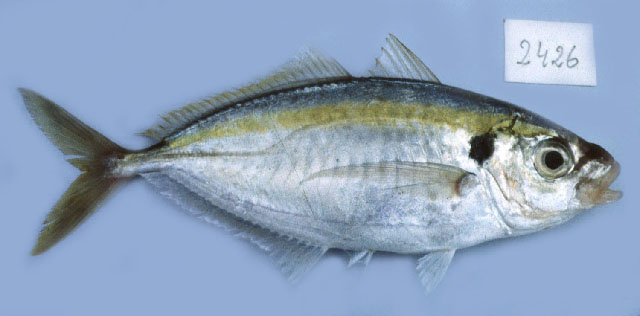| Carangidae (Jacks and pompanos), subfamily: Caranginae |
| 22 cm TL (male/unsexed); max.weight: 625.0 g |
|
reef-associated; brackish; marine; depth range 1 - 50 m, amphidromous |
| Indo-West Pacific: Persian Gulf to the Philippines, north to Japan, south to the Arafura Sea (Ref. 9819) and Australia (Ref. 3287). |
|
Dorsal spines (total): 9-9; Dorsal soft rays (total): 24-26; Anal spines: 3-3; Anal soft rays: 21-23. Description: Dorsal metallic blue, ventral silvery white; stripe yellow broad from eye upper margin to caudal peduncle; opercle edge with spot black, large. Body elongate, oblong, compressed; profiles dorsal less convex than ventral. Eyes very large, shorter than snout length; adipose eyelid well developed, covering eye posterior part. Upper jaw strongly protractile. Breast scaled. LL curved part shorter than straight part 0.6-0.8 times; LL scales are on straight part; LL scutes 24-29, small. Cleithrum smooth without papillae. Pectoral fins falcate; anal fins first two spines detached. (Ref. 2334. 90102) |
| Adults occur in inshore waters of the continental shelf (Ref. 7300). They form large demersal schools over soft bottom habitats at depths shallower than 50 m. Sometimes they ascend into freshwater reaches like the freshwater tidal zone in the Mekong delta (Ref. 12693). Ostracods, gastropods and euphausiids are common prey but small fish are also taken. |
|
Least Concern (LC); Date assessed: 09 March 2015 Ref. (130435)
|
| harmless |
Source and more info: www.fishbase.org. For personal, classroom, and other internal use only. Not for publication.
